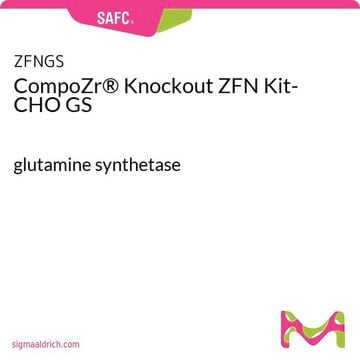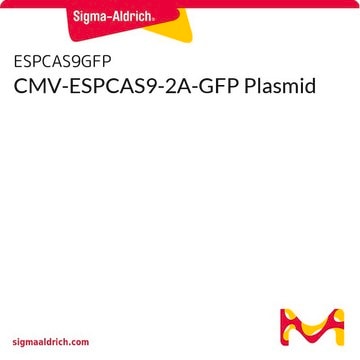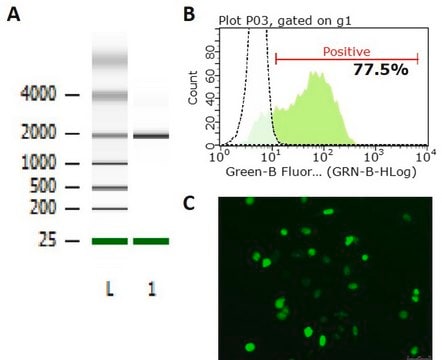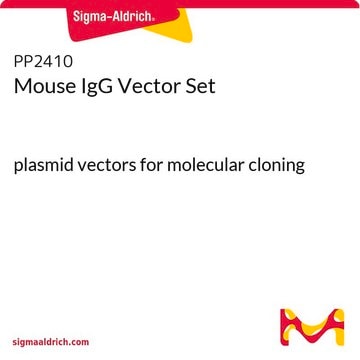CSTZFN
CompoZr® Custom Zinc Finger Nuclease (ZFN)
ZFN plasmid and mRNA
Synonym(s):
Zinc Finger Nuclease
Sign Into View Organizational & Contract Pricing
All Photos(1)
About This Item
UNSPSC Code:
12352200
Recommended Products
product line
CompoZr®
shipped in
dry ice
storage temp.
−70°C
Looking for similar products? Visit Product Comparison Guide
Related Categories
General description
Zinc Finger Nucleases (ZFNs) are a class of engineered DNA-binding proteins that facilitate targeted editing of the genome by creating double-strand breaks in DNA at user-specified locations. Double-strand breaks are important for site-specific mutagenesis in that they stimulate the cell′s natural DNA-repair processes, namely homologous recombination and Non-Homologous End Joining (NHEJ). By implementing established, field-proven methods, these processes can be harnessed to generate precisely targeted genomic edits, resulting in cell lines with precise and heritable gene deletions, integrations or modifications.
Application
Functional Genomics/Target Validation
- Creation of gene knockouts in multiple cell lines
- Complete knockout of genes not amenable to RNAi
- Creation of knock-in cell lines with promoters, fusion tags or reporters integrated into endogenous genes
- Creation of cell lines that produce higher yields of proteins or antibodies
The CompoZr Custom ZFN service can be used to target genes from a variety of organisms. Validation of the custom ZFNs is completed in a proxy cell line for human, mouse, rat and hamster (CHO) projects. In this assay, the candidate ZFNs are delivered to the proxy cell line and activity is identified and measured. Activity is measured by amplifying over the ZFN target site and then using a nuclease mismatch enzyme to cut DNA strands that have been modified. ZFN efficiency can be measured based on the densitometry results of this assay. CompoZr Custom ZFN Projects for human, mouse, rat, and hamster (CHO) will have a production timeline of 10 weeks after the ZFN design is approved.
Features and Benefits
- Rapid design, assembly, and validation of a ZFN pair targeting your gene of interest
- Rapid and permanent disruption of, or integration into, any genomic loci
- Mutations made are permanent and heritable
- Works in a variety of mammalian somatic cell types
- Edits induced through a single transfection experiment
- Knockout or knock-in cell lines in as little as two months
- Single or biallelic edits occur in 1-20% of clone population
- No antibiotic selection required for screening
Components
- Best Performing ZFN Pair
- 10 Aliquots of Ready-to-Deliver ZFN Pair in mRNA form
- ZFN Pair in Plasmid Form
- Forward and Reverse Primers that allow for determination of rate of mutation and for screening of individual clones
- Positive Control DNA
- Used to determine a baseline cutting efficiency
Other Notes
To have a ZFN made targeting your gene of interest, please inquire about our
Custom ZFN Service offering HERE
Custom ZFN Service offering HERE
Legal Information
All Zinc Finger Nucleases are sold under license from Sangamo Biosciences. For a copy of the Label License provided with purchase of CompoZr ZFNs, please visit the ZFN Label License page.
CompoZr is a registered trademark of Merck KGaA, Darmstadt, Germany
related product
Product No.
Description
Pricing
Storage Class Code
10 - Combustible liquids
Flash Point(F)
Not applicable
Flash Point(C)
Not applicable
Certificates of Analysis (COA)
Search for Certificates of Analysis (COA) by entering the products Lot/Batch Number. Lot and Batch Numbers can be found on a product’s label following the words ‘Lot’ or ‘Batch’.
Already Own This Product?
Find documentation for the products that you have recently purchased in the Document Library.
Chun Cheng Andy Chen et al.
Physiological genomics, 45(3), 110-118 (2012-12-20)
The present study employed a zinc-finger nuclease strategy to create heterozygous knockout (KO) rats for the transforming growth factor-β1 (Tgfb1) gene on the Dahl SS/Jr genetic background (TGF-β1(+/-) Dahl S). Intercrossing TGF-β1(+/-) rats did not produce any homozygous KO rats
Bettina Schmid et al.
Proceedings of the National Academy of Sciences of the United States of America, 110(13), 4986-4991 (2013-03-05)
Mutations in the Tar DNA binding protein of 43 kDa (TDP-43; TARDBP) are associated with amyotrophic lateral sclerosis (ALS) and frontotemporal lobar degeneration with TDP-43(+) inclusions (FTLD-TDP). To determine the physiological function of TDP-43, we knocked out zebrafish Tardbp and
A Tanaka et al.
Leukemia, 27(8), 1621-1627 (2013-02-16)
Human T-cell leukemia virus type 1 (HTLV-1), which causes adult T-cell leukemia (ATL) in humans, establishes a life-long latent infection. Current therapies are not very effective against HTLV-1-associated disorders. A novel therapeutic approach may help to combat HTLV-1 infection. A
Carolyn Bentley et al.
The Biochemical journal, 452(2), 313-320 (2013-03-19)
The mutant forms of KRas, NRas and HRas drive the initiation and progression of a number of human cancers, but less is known about the role of WT (wild-type) Ras alleles and isoforms in cancer. We used zinc-finger nucleases targeting
Frauke van Bebber et al.
Journal of neurochemistry, 127(4), 471-481 (2013-02-15)
Alzheimer's disease is the most frequent dementia. Pathologically, Alzheimer's disease is characterized by the accumulation of senile plaques composed of amyloid β-peptide (Aβ). Two proteases, β- and γ-secretase proteolytically generate Aβ from its precursor, the ß-amyloid precursor protein (APP). Inhibition
Our team of scientists has experience in all areas of research including Life Science, Material Science, Chemical Synthesis, Chromatography, Analytical and many others.
Contact Technical Service








